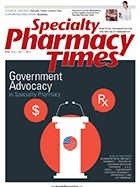Publication
Article
Specialty Pharmacy Times
Remedies for the Unintended Consequences of the ACA
Author(s):
The Affordable Care Act has created a glut of patients awaiting authorization for the therapies payers have longed for.
FACT: THE AFFORDABLE CARE ACT (ACA) succeeded in increasing the number of insured Americans.
According to the National Center for Health Statistics, there were 16 million fewer uninsured Americans as of September 2015, than in 2013. More specifically, the percentage of uninsured adults aged 18-64 decreased from 22% in 2010 to 13% in the first 9 months of 2015.1
One unintended consequence of the ACA, however, is the creation of a glut of patients awaiting authorization for the exact therapies, or actual cures, for which payers have long clamored.
What is even worse, some patients who stand to benefit most from specialty medications have their prescriptions authorized and filled, only to learn that refills of Harvoni, for example, run into a monthly prior authorization barrier from their pharmacy benefit manager or payer.
At risk of failing to adhere to the costly but valuable regimen due to this barrier, the patient, their payer, and their physician increase the collective risk of resistance to the therapy. We are learning that new curative therapies cannot be treated the same way as legacy and low-cost medication therapies.
Rising Number of Insured + Rising Numbers of Specialty Drugs and Prices = Roadblocks to Value
According to a recent report from The Pew Charitable Trusts, less than 1% of all prescriptions were written for specialty drugs in 2014, yet they accounted for approximately 32% of total drug expenditures.
“Utilization rose by 5.8% in 2014 because of increased use of existing drugs and the introduction of new pharmaceuticals. In 1990, only 10 specialty drugs were on the market,” the authors wrote. “Currently, approximately 300 such drugs are on the market, 19 of which became available in 2014 alone. And nearly 700 specialty drugs are under development.”2
The meteoric increase in the number and cost of specialty medications, added to the growing population of insured Americans, has created a one-two punch in the guts for patients and providers. While the average time per patient interaction for clinicians continues to shrink, providers are now mired in a worsening administrative bog of prior authorization forms.
At the same time, patients often forego therapy—putting them at greater risk of becoming acute or requiring other, more costly care–due to slow prior authorization processes or out-of-pocket costs, including medication co-payments, they simply cannot afford. It’s a situation akin to classic traffic congestion.
Increasing the volume of vehicles to a constant volume of highway capacity breeds gridlock. Adding new lanes, an immensely expensive proposition, is only a short-term solution. What is needed is taking vehicles off of the roads by giving users effective alternatives.
In the same way bike paths and mass transportation options move people efficiently through a city, pharmaceutical industry alignment should improve access, adherence, and outcomes for all concerned.
Where There is Hope and a Productive Path Forward
In November 2015, pharma’s at-risk day in the United States arrived with the announcement of the Harvard Pilgrim deal with Amgen for the PCSK9 inhibitor Repatha. Others have since followed, including Aetna and Cigna’s agreement with Novartis for its heart failure drug Entresto.
Through these value-based agreements, payers recoup additional rebates from manufacturers if patients do not achieve specific outcomes targets. Given the need for improved alignment within the entire industry (manufacturers, payers, providers and patients), at-risk or value-based contracts are a solid advancement in value-based care.
What is needed next is agreement on outcomes metrics and a near-neutral arbiter of those outcomes. According to a Kaiser Family Foundation “Health Tracking Poll” from February 2016, 36% of Americans say policymakers should build on the ACT to improve affordability and access to care.
Sixteen percent said they would like to see the health care law repealed and not replaced, 13% said it should be repealed and replaced with a Republican-sponsored alternative, and 24% said the United States should establish guaranteed universal coverage through a single government plan.3
To our respective parties’ candidates in the race to be the 45th President of the United States, I say: no matter which approach you take to national health care, the longest lever available to increasing value by improving outcomes and reducing overall costs is medication adherence.
According to a report from the US Centers for Disease Control and Prevention, medication nonadherence accounts for $100 billion to $289 billion in wasted health care spending every year.4
AbbVie sponsored a study in April 2015, where the sample included patients aged 18 years or older with a diagnosis of Crohn’s disease, ulcerative colitis, rheumatoid arthritis, psoriasis, psoriatic arthritis, or ankylosing spondylitis.
The study abstract, published in the Journal of Managed Care and Specialty Pharmacy, found that AbbVie’s Humira Ambassadors patient assistance and education program:
- Lowered 12-month medical cost by 23% associated with patients using patient support program (PSP)
- Lowered disease-related medical cost for PSP patients by 22%
- Lowered total costs for patients enrolled in the PSP program by 10%5
A study published, in 2012, by Curant Health CEO, Patrick Dunham, and Jeffrey Karkula, RPh, BSPharm, demonstrated the impact of medication therapy management on a population of HIV patients taking Highly Active Antiretroviral Therapy (HAART):
- Medication adherence was increased by 28% over baseline through enhanced medication therapy management.
- There was a 69% increase in patients who were at least 95% adherent to all medications; 95% represents the commonly applied definition of an acceptable level of adherence to HAART.
- The percentage of patients whose viral loads were considered undetectable increased from 28% to 66% with medication therapy management.
- The same patients’ overall health care costs decreased $3,000 per patient per year.6
Directing CMS to expand upon its definition of medication therapy management and adding it to the Chronic Care Management program is one way the next president can lead the nation to better health, the moment he or she takes office.
CMS also has the capability to effectively accelerate the shift to value-based care by more clearly defining value as outcomes divided by costs, committing to reliable outcomes measurement, and improving adherence rates through effective medication management among the nation’s chronically ill patients.
As the nation’s largest payer and arguably the nation’s largest driver of health care innovation, CMS should lead the charge and our next president should ensure they do so. SPT
References
1. National Center for Health Statistics. Health Insurance Coverage: Early Release of Estimates From the National Health Interview Survey, January—September 2015. http://www.cdc.gov/nchs/data/nhis/earlyrelease/insur201602.pdf. Published February 2016. Accessed February 2016.
2. The Pew Charitable Trusts. Specialty Drugs and Health Care Costs. http://www.pewtrusts.org/~/media/assets/2015/11/specialty-drugs-and-health-care-costs_artfinal.pdf. Published November 2015. Accessed February 2016.
3. The Henry J. Kaiser Family Foundation. Kaiser Health Tracking Poll: February 2016. http://kff.org/health-reform/poll-finding/kaiser-health-tracking-poll-february-2016. Published February 2016. Accessed February 2016.
4. US Centers for Disease Control and Prevention. Medication Adherence. http://www.cdc.gov/primarycare/materials/medication/docs/medication-adherence-01ccd.pdf. Published March 2013. Accessed February 2016.
5. Rubin D, Skup M, Davis M, Johnson S, Chao J. University of Chicago Medicine; AbbVie; Medicus Economics. Impact of AbbVie’s Patient Support Program on Resource Costs in Crohn’s Disease, Ulcerative Colitis, Rheumatoid Arthritis, Psoriasis, Psoriatic Arthritis, and Ankylosing Spondylitis. (See U7, page S74) Meeting Abstracts Academy of Managed Care Pharmacy 2015 Annual Meeting& Expo. Published April 2015. Accessed February 2016.
6. Dunham, P and Karkula, J. “Effects of a Pharmacy-Care Program on Adherence and Outcomes.” Am J Pharm Benefits. 2012;4(1):e8-e14. January/February 2012. http://www.ajmc.com/journals/issue/2012/ajpb_janfeb2012/effects-of-a-pharmacy-care-program-on-adherence-and-outcomes. Accessed February 2016.

is chief operating office for Curant Health, a provider of enhanced medication therapy management and specialty pharmacy services proven to improve patient outcomes and reduce total health care spending. Marc is also a board member of the Team Type 1 Foundation, an organization whose mission is to “instill hope and inspiration for people around the world affected by diabetes.”







